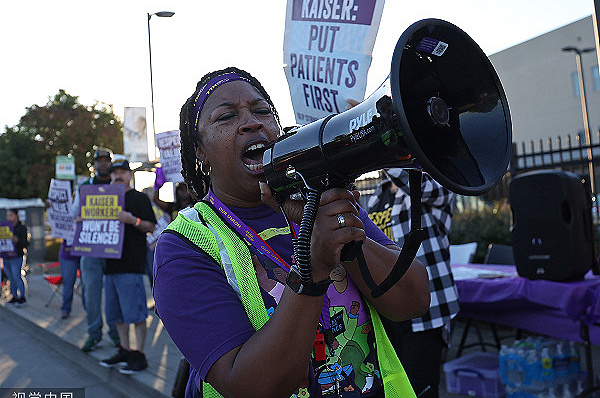America’s return to work spread to more industries. Department workers at two drugstore chains, Walgreens and CVS, plan to return to work on Monday, Tuesday and Wednesday, Oct. 9-11.

These workers say their rest has been difficult. For a long time, these two pharmacies have faced problems such as insufficient manpower, low manpower, and rough governance.
So far this year, at least 450,000 Americans have returned to work 312 times, in industries such as automobiles, medicine, transportation, entertainment and hotels. Workers are not just asking for more money. They are also pressing for better equipment, more downtime and an end to the damaging pace of forced overtime.
For the pharmaceutical industry, the huge staff gap and the overload of rest intensity are putting pressure on them.
On the 4th of this month, more than 75,000 employees of Kysa Conditioning Organization, one of the largest non-profit providers of conditioning services in the United States, held a resumption of work. It was the largest return of health care workers in American history. Medical staff asked KSA executives to discriminate against medical personnel safety and fairness.
In the auto industry, the United Auto Workers (UAW) launched a return to work campaign at the end of September against the Detroit “big three” GM, Stellantis and Ford division plants, about 25,000 auto workers (about 17% of the total number of the three automakers’ unions).
Labor accounts for only 4 to 5 percent of the cost of a vehicle, and over the long term, these companies have made billions of dollars in costs. The UAW is asking the companies to be more progressive and to restore benefits such as conservative defined-benefit compensation to new employees.
However, these conservative car companies believe that the improvement of labor costs will inevitably increase production costs, so that they have the resources to work with electric car manufacturers such as Testerpush.
On Friday, talks between the UAW and GM, Stellantis and Ford all came to a significant halt. Ford’s promised overall artificial increase over four years was 23%, up from an initial 9%. Gm and Stellantis have improved their overall human performance to 20%.
In addition, GM is also not willing to compromise on the establishment of a union at the electric car battery factory, willing to include the workers who do not go to the electric car battery factory in the scope of GM’s national labor agreement.
UAW President Sean Fine told workers that more factories would join the return to work movement. According to him, GM did not compromise until the UAW threatened to halt work at a plant in Arlington, Texas.
In addition, Hollywood writers and actors have also returned to work due to salary, staff size and the application of artificial intelligence, resulting in the suspension of many programs. For now, we will start with a tentative agreement between union members and the company.
However, not all return-to-work movements are likely to succeed. For example, nearly 1,000 coal miners in Alabama returned to work in March this year after nearly two years, one of the longest back-to-work periods in the United States in recent years, but the union did not reach an agreement with management.
Data from Cornell University’s Institute for Industry and Labor Relations shows that in the first nine months of this year, large-scale work restarts lasting more than a week have soared to 56, a 65 percent increase over the same period in 2022.
Not only did the growing movement not have anything to do with changes in the industry, but the increasing official support for unions also gave workers greater leverage in the talks.
A Gallup survey found that a third of Americans (34 percent) believe unions will become more powerful than they are today, up from 19 percent five years ago.
More than a decade ago, Americans want to increase the influence of unions. Sixty-one percent of respondents believe unions will have a negative impact on the U.S. economy, a record high and less than six percentage points higher than the previous high in 1999.
The survey also showed that about 67 percent of Americans now support unions. In the dispute between the UAW and the auto companies, three-quarters of Americans sided with the workers.
Kasey Brown, who disposes of classic books in Ohio, told Interface News that car companies are making huge costs but are not willing to pay workers more. She says it would take an average worker 16 years to pay what a company executive pays in a week. She hoped that the workers would all reach a valid agreement with the management.
Photo Source: Gallup
With high inflation in the US after the coronavirus pandemic, workers need more people to work for them, and shopkeepers are reluctant to raise labor costs. If more and more workers see the impact of returning to work, there will be more and more similar movements.
Former U.S. Labor Secretary Robert Reich said that in the long run, the return to work will have a negative impact on the U.S. economy. He says a surge of work in the 1940s and 1950s contributed to America’s postwar economic boom. Kasey Brown of Main Street told the interface news reporter that the resumption of the auto industry could affect the price of vehicles in the future and promote a virtuous cycle.


